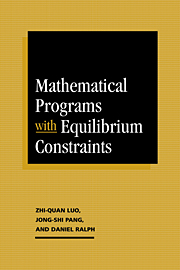5 - Second-Order Optimality Conditions
Published online by Cambridge University Press: 05 December 2011
Summary
As for a standard NLP, we can derive some second-order necessary and second-order sufficient conditions for a local minimum of an MPEC. This chapter is a foray into these second-order conditions. For convenience, throughout we require polyhedrality of the upper-level feasible region Z; initially, we also assume the same for the constraint set C(x) in the lower-level VI for all x ∈ dom(C). In standard nonlinearly constrained NLPs, second-order conditions at boundary points must generally account for the curvature of the boundary. Such curvature requirement is usually contained in the positive definiteness properties of the partial Hessian matrix of the Lagrangean function of the nonlinear program, which contains not only the Hessian matrix of the objective function, but also the sum of the Hessian matrices of the active constraint functions, using the KKT multipliers as weights; cf. the discussion on SCOC in Subsection 4.2.7. Initially we confine our interest to polyhedral sets to keep the ideas and analysis relatively simple. Even in this situation, the treatment is complicated by the equilibrium constraint (x,y) ∈ Gr S which, as we have seen in the case of the first-order analysis, leads to some combinatorial considerations that are not present in standard nonlinear programming. Indeed, such complications become more pronounced as we work with the second-order conditions in this chapter.
This chapter discusses a multiplier-based approach, an implicit programming approach, and a piecewise programming approach to the derivation of second-order optimality conditions of MPECs; the treatment here extends ideas of the previous two chapters. Overall, the development here is parallel to that of Chapter 4. Specifically, besides the next section which reviews known NLP theory, there are five sections in the chapter.
- Type
- Chapter
- Information
- Mathematical Programs with Equilibrium Constraints , pp. 223 - 270Publisher: Cambridge University PressPrint publication year: 1996



